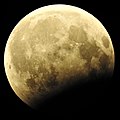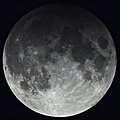September 1996 lunar eclipse
 From Wikipedia - Reading time: 10 min
From Wikipedia - Reading time: 10 min
| Total eclipse | |||||||||||||||||
 The mid-infrared image of the Moon taken by the SPIRIT-III instrument aboard the orbiting Midcourse Space Experiment (MSX) satellite. | |||||||||||||||||
| Date | September 27, 1996 | ||||||||||||||||
|---|---|---|---|---|---|---|---|---|---|---|---|---|---|---|---|---|---|
| Gamma | 0.3426 | ||||||||||||||||
| Magnitude | 1.2395 | ||||||||||||||||
| Saros cycle | 127 (41 of 72) | ||||||||||||||||
| Totality | 69 minutes, 12 seconds | ||||||||||||||||
| Partiality | 203 minutes, 17 seconds | ||||||||||||||||
| Penumbral | 320 minutes, 52 seconds | ||||||||||||||||
| |||||||||||||||||
A total lunar eclipse occurred at the Moon’s descending node of orbit on Friday, September 27, 1996,[1] with an umbral magnitude of 1.2395. A lunar eclipse occurs when the Moon moves into the Earth's shadow, causing the Moon to be darkened. A total lunar eclipse occurs when the Moon's near side entirely passes into the Earth's umbral shadow. Unlike a solar eclipse, which can only be viewed from a relatively small area of the world, a lunar eclipse may be viewed from anywhere on the night side of Earth. A total lunar eclipse can last up to nearly two hours, while a total solar eclipse lasts only a few minutes at any given place, because the Moon's shadow is smaller. Occurring about 2.2 days after perigee (on September 24, 1996, at 22:40 UTC), the Moon's apparent diameter was larger.[2]
This lunar eclipse was the second of an almost tetrad, with the others being on April 4, 1996 (total); March 24, 1997 (partial); and September 16, 1997 (total).
Visibility
[edit]The eclipse was completely visible over eastern North America, South America, western Europe, and west Africa, seen rising over western North America and the eastern and central Pacific Ocean and setting over eastern Europe, central and east Africa, and the western half of Asia.[3]
 
|
Mid-infrared image of the Moon
[edit]During its totality, the Midcourse Space Experiment (MSX) satellite's SPIRIT-III instrument took the image of the Moon in mid-infrared. At these wavelengths, MSX was able to characterize the thermal (heat) distribution of the lunar surface during the eclipse. The brightest regions are the warmest, and the darkest areas are the coolest. The well-known crater Tycho is the bright object to the south of center. Numerous other craters are also seen as bright spots, indicating that their temperature is higher than in the surrounding dark mare.[4]
Eclipse details
[edit]Shown below is a table displaying details about this particular solar eclipse. It describes various parameters pertaining to this eclipse.[5]
| Parameter | Value |
|---|---|
| Penumbral Magnitude | 2.21885 |
| Umbral Magnitude | 1.23953 |
| Gamma | 0.34264 |
| Sun Right Ascension | 12h15m43.1s |
| Sun Declination | -01°42'06.3" |
| Sun Semi-Diameter | 15'57.5" |
| Sun Equatorial Horizontal Parallax | 08.8" |
| Moon Right Ascension | 00h15m18.1s |
| Moon Declination | +02°01'37.4" |
| Moon Semi-Diameter | 16'17.8" |
| Moon Equatorial Horizontal Parallax | 0°59'48.4" |
| ΔT | 62.1 s |
Eclipse season
[edit]This eclipse is part of an eclipse season, a period, roughly every six months, when eclipses occur. Only two (or occasionally three) eclipse seasons occur each year, and each season lasts about 35 days and repeats just short of six months (173 days) later; thus two full eclipse seasons always occur each year. Either two or three eclipses happen each eclipse season. In the sequence below, each eclipse is separated by a fortnight.
| September 27 Descending node (full moon) |
October 12 Ascending node (new moon) |
|---|---|
 |

|
| Total lunar eclipse Lunar Saros 127 |
Partial solar eclipse Solar Saros 153 |
Related eclipses
[edit]Eclipses in 1996
[edit]- A total lunar eclipse on April 4.
- A partial solar eclipse on April 17.
- A total lunar eclipse on September 27.
- A partial solar eclipse on October 12.
Metonic
[edit]- Preceded by: Lunar eclipse of December 9, 1992
- Followed by: Lunar eclipse of July 16, 2000
Tzolkinex
[edit]- Preceded by: Lunar eclipse of August 17, 1989
- Followed by: Lunar eclipse of November 9, 2003
Half-Saros
[edit]- Preceded by: Solar eclipse of September 23, 1987
- Followed by: Solar eclipse of October 3, 2005
Tritos
[edit]- Preceded by: Lunar eclipse of October 28, 1985
- Followed by: Lunar eclipse of August 28, 2007
Lunar Saros 127
[edit]- Preceded by: Lunar eclipse of September 16, 1978
- Followed by: Lunar eclipse of October 8, 2014
Inex
[edit]- Preceded by: Lunar eclipse of October 18, 1967
- Followed by: Lunar eclipse of September 7, 2025
Triad
[edit]- Preceded by: Lunar eclipse of November 27, 1909
- Followed by: Lunar eclipse of July 29, 2083
Lunar eclipses of 1995–1998
[edit]This eclipse is a member of a semester series. An eclipse in a semester series of lunar eclipses repeats approximately every 177 days and 4 hours (a semester) at alternating nodes of the Moon's orbit.[6]
The penumbral lunar eclipse on August 8, 1998 occurs in the next lunar year eclipse set.
| Lunar eclipse series sets from 1995 to 1998 | ||||||||
|---|---|---|---|---|---|---|---|---|
| Ascending node | Descending node | |||||||
| Saros | Date Viewing |
Type Chart |
Gamma | Saros | Date Viewing |
Type Chart |
Gamma | |
| 112 | 1995 Apr 15
|
Partial
|
−0.9594 | 117 | 1995 Oct 08
|
Penumbral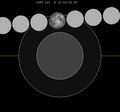
|
1.1179 | |
122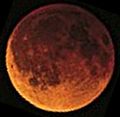
|
1996 Apr 04
|
Total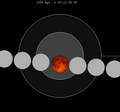
|
−0.2534 | 127
|
1996 Sep 27
|
Total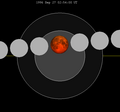
|
0.3426 | |
132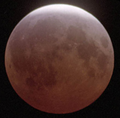
|
1997 Mar 24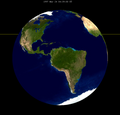
|
Partial
|
0.4899 | 137 | 1997 Sep 16
|
Total
|
−0.3768 | |
| 142 | 1998 Mar 13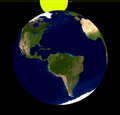
|
Penumbral
|
1.1964 | 147 | 1998 Sep 06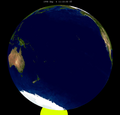
|
Penumbral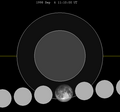
|
−1.1058 | |
Saros 127
[edit]This eclipse is a part of Saros series 127, repeating every 18 years, 11 days, and containing 72 events. The series started with a penumbral lunar eclipse on July 9, 1275. It contains partial eclipses from November 4, 1473 through May 18, 1780; total eclipses from May 29, 1798 through November 9, 2068; and a second set of partial eclipses from November 20, 2086 through June 17, 2429. The series ends at member 72 as a penumbral eclipse on September 2, 2555.
The longest duration of totality was produced by member 35 at 101 minutes, 46 seconds on July 23, 1888. All eclipses in this series occur at the Moon’s descending node of orbit.[7]
| Greatest | First | |||
|---|---|---|---|---|
| The greatest eclipse of the series occurred on 1888 Jul 23, lasting 101 minutes, 46 seconds.[8] | Penumbral | Partial | Total | Central |
| 1275 Jul 09 |
1473 Nov 04 |
1798 May 29 |
1834 Jun 21 | |
| Last | ||||
| Central | Total | Partial | Penumbral | |
1960 Sep 05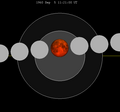
|
2068 Nov 09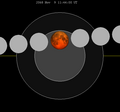
|
2429 Jun 17 |
2555 Sep 02 | |
Eclipses are tabulated in three columns; every third eclipse in the same column is one exeligmos apart, so they all cast shadows over approximately the same parts of the Earth.
| Series members 31–52 occur between 1801 and 2200: | |||||
|---|---|---|---|---|---|
| 31 | 32 | 33 | |||
| 1816 Jun 10 | 1834 Jun 21 | 1852 Jul 01 | |||
| 34 | 35 | 36 | |||
| 1870 Jul 12 | 1888 Jul 23 | 1906 Aug 04 | |||

|
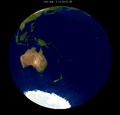
| ||||
| 37 | 38 | 39 | |||
| 1924 Aug 14 | 1942 Aug 26 | 1960 Sep 05 | |||
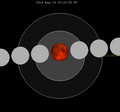
|

|

|

|

|

|
| 40 | 41 | 42 | |||
| 1978 Sep 16 | 1996 Sep 27 | 2014 Oct 08 | |||

|

|

|

|

|
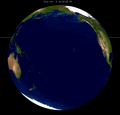
|
| 43 | 44 | 45 | |||
| 2032 Oct 18 | 2050 Oct 30 | 2068 Nov 09 | |||

|

|
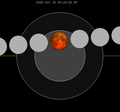
|

|

|
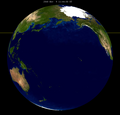
|
| 46 | 47 | 48 | |||
| 2086 Nov 20 | 2104 Dec 02 | 2122 Dec 13 | |||
| 49 | 50 | 51 | |||
| 2140 Dec 23 | 2159 Jan 04 | 2177 Jan 14 | |||
| 52 | |||||
| 2195 Jan 26 | |||||
Tritos series
[edit]This eclipse is a part of a tritos cycle, repeating at alternating nodes every 135 synodic months (≈ 3986.63 days, or 11 years minus 1 month). Their appearance and longitude are irregular due to a lack of synchronization with the anomalistic month (period of perigee), but groupings of 3 tritos cycles (≈ 33 years minus 3 months) come close (≈ 434.044 anomalistic months), so eclipses are similar in these groupings.
| Series members between 1801 and 2200 | |||||||||
|---|---|---|---|---|---|---|---|---|---|
| 1811 Mar 10 (Saros 110) |
1822 Feb 06 (Saros 111) |
1833 Jan 06 (Saros 112) |
1843 Dec 07 (Saros 113) |
1854 Nov 04 (Saros 114) | |||||
| 1865 Oct 04 (Saros 115) |
1876 Sep 03 (Saros 116) |
1887 Aug 03 (Saros 117) |
1898 Jul 03 (Saros 118) |
1909 Jun 04 (Saros 119) | |||||

|

| ||||||||
| 1920 May 03 (Saros 120) |
1931 Apr 02 (Saros 121) |
1942 Mar 03 (Saros 122) |
1953 Jan 29 (Saros 123) |
1963 Dec 30 (Saros 124) | |||||
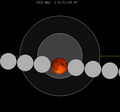
|
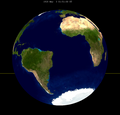
|

|

|

|

|

|

|
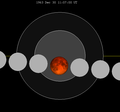
|

|
| 1974 Nov 29 (Saros 125) |
1985 Oct 28 (Saros 126) |
1996 Sep 27 (Saros 127) |
2007 Aug 28 (Saros 128) |
2018 Jul 27 (Saros 129) | |||||

|

|

|
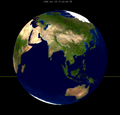
|

|

|
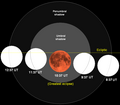
|
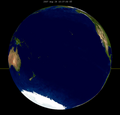
|

|

|
| 2029 Jun 26 (Saros 130) |
2040 May 26 (Saros 131) |
2051 Apr 26 (Saros 132) |
2062 Mar 25 (Saros 133) |
2073 Feb 22 (Saros 134) | |||||

|
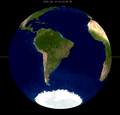
|
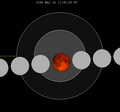
|

|

|
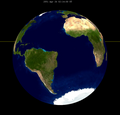
|
||||
| 2084 Jan 22 (Saros 135) |
2094 Dec 21 (Saros 136) |
2105 Nov 21 (Saros 137) |
2116 Oct 21 (Saros 138) |
2127 Sep 20 (Saros 139) | |||||

|
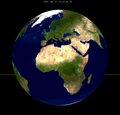
|
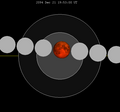
|

|
||||||
| 2138 Aug 20 (Saros 140) |
2149 Jul 20 (Saros 141) |
2160 Jun 18 (Saros 142) |
2171 May 19 (Saros 143) |
2182 Apr 18 (Saros 144) | |||||
| 2193 Mar 17 (Saros 145) | |||||||||
Inex series
[edit]This eclipse is a part of the long period inex cycle, repeating at alternating nodes, every 358 synodic months (≈ 10,571.95 days, or 29 years minus 20 days). Their appearance and longitude are irregular due to a lack of synchronization with the anomalistic month (period of perigee). However, groupings of 3 inex cycles (≈ 87 years minus 2 months) comes close (≈ 1,151.02 anomalistic months), so eclipses are similar in these groupings.
| Series members between 1801 and 2200 | |||||
|---|---|---|---|---|---|
| 1823 Jan 26 (Saros 121) |
1852 Jan 07 (Saros 122) |
1880 Dec 16 (Saros 123) | |||
| 1909 Nov 27 (Saros 124) |
1938 Nov 07 (Saros 125) |
1967 Oct 18 (Saros 126) | |||
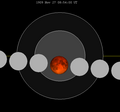
|
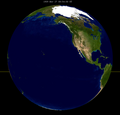
|

|

|

|
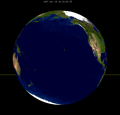
|
| 1996 Sep 27 (Saros 127) |
2025 Sep 07 (Saros 128) |
2054 Aug 18 (Saros 129) | |||

|

|

|

|

|
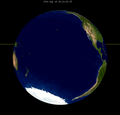
|
| 2083 Jul 29 (Saros 130) |
2112 Jul 09 (Saros 131) |
2141 Jun 19 (Saros 132) | |||

|
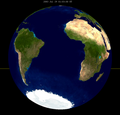
|
||||
| 2170 May 30 (Saros 133) |
2199 May 10 (Saros 134) | ||||
Half-Saros cycle
[edit]A lunar eclipse will be preceded and followed by solar eclipses by 9 years and 5.5 days (a half saros).[9] This lunar eclipse is related to two annular solar eclipses of Solar Saros 134.
| September 23, 1987 | October 3, 2005 |
|---|---|

|

|
See also
[edit]References
[edit]- ^ "September 26–27, 1996 Total Lunar Eclipse (Blood Moon)". timeanddate. Retrieved 9 January 2025.
- ^ "Moon Distances for London, United Kingdom, England". timeanddate. Retrieved 9 January 2025.
- ^ "Total Lunar Eclipse of 1996 Sep 27" (PDF). NASA. Retrieved 9 January 2025.
- ^ NASA Astronomy Picture of the Day: Eclipsed Moon in Infrared (8 November 2003)
- ^ "Total Lunar Eclipse of 1996 Sep 27". EclipseWise.com. Retrieved 9 January 2025.
- ^ van Gent, R.H. "Solar- and Lunar-Eclipse Predictions from Antiquity to the Present". A Catalogue of Eclipse Cycles. Utrecht University. Retrieved 6 October 2018.
- ^ "NASA - Catalog of Lunar Eclipses of Saros 127". eclipse.gsfc.nasa.gov.
- ^ Listing of Eclipses of series 127
- ^ Mathematical Astronomy Morsels, Jean Meeus, p.110, Chapter 18, The half-saros
External links
[edit]- Saros cycle 127
- 1996 Sep 27 chart Eclipse Predictions by Fred Espenak, NASA/GSFC
- September 1996 lunar eclipse
 KSF
KSF